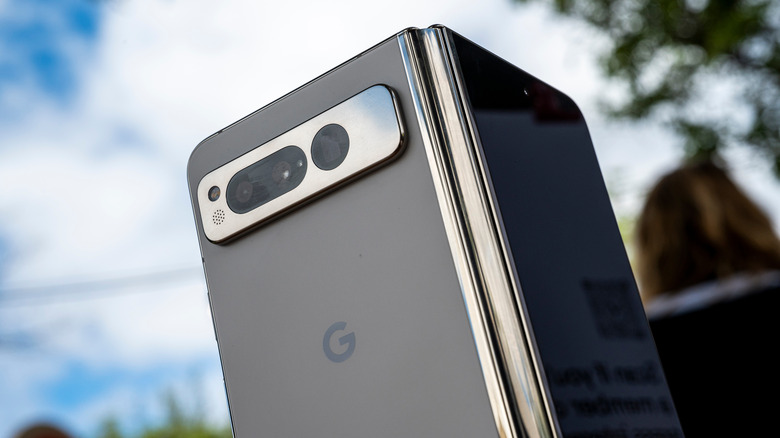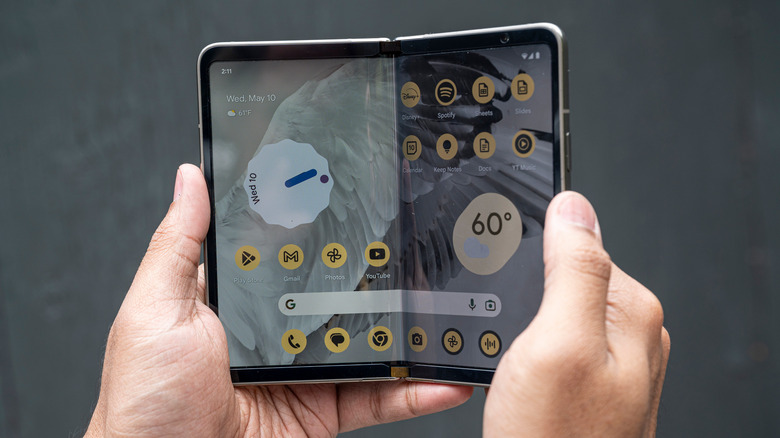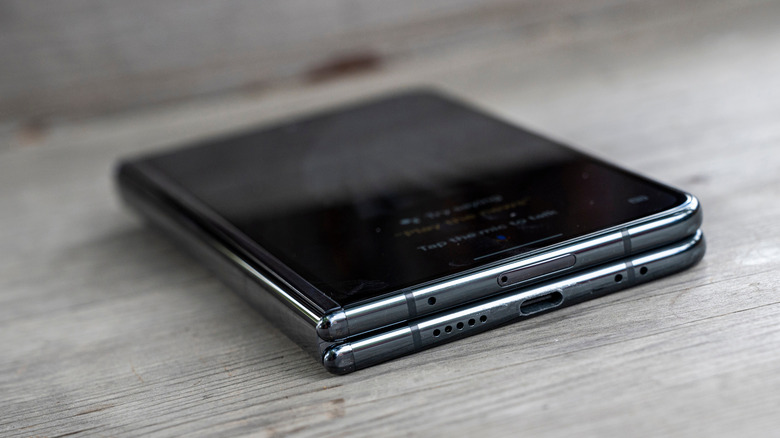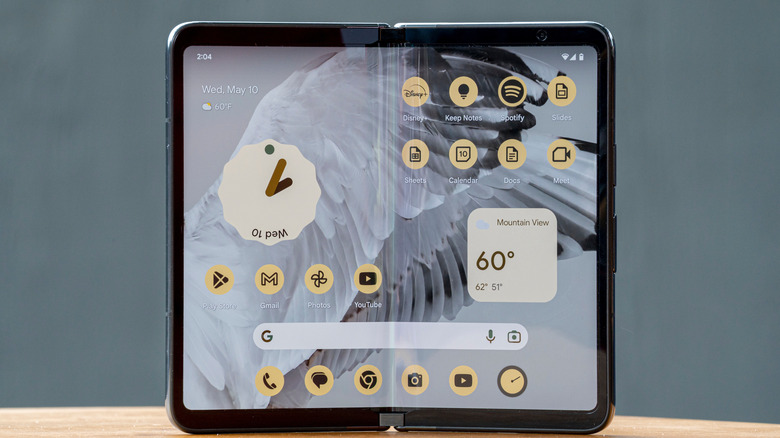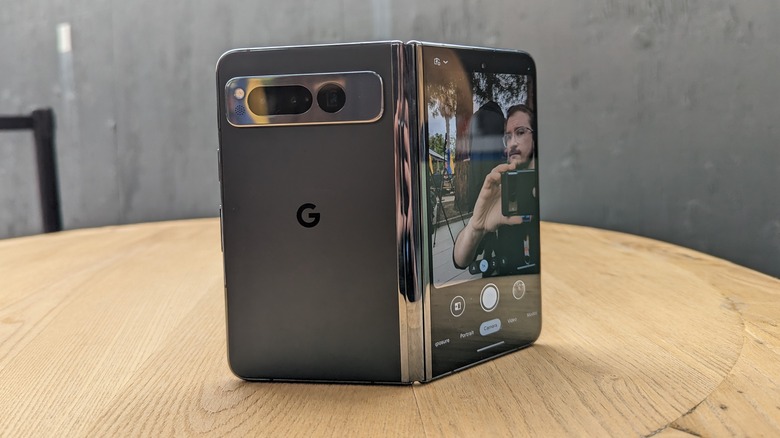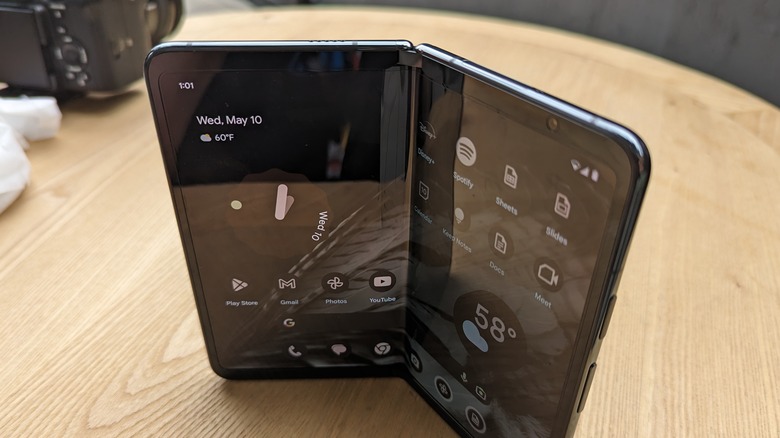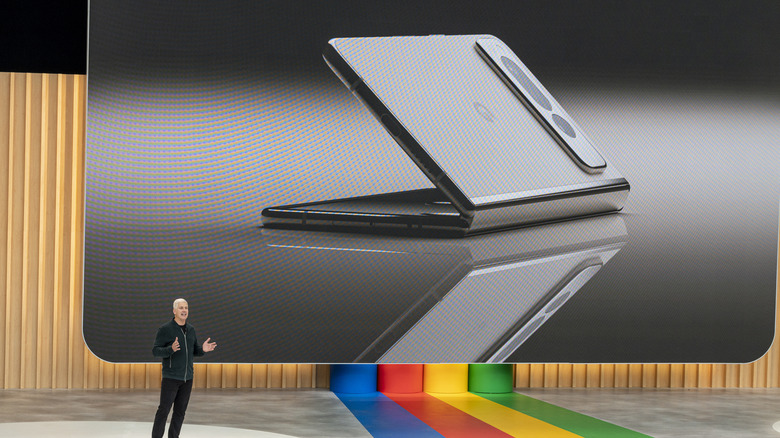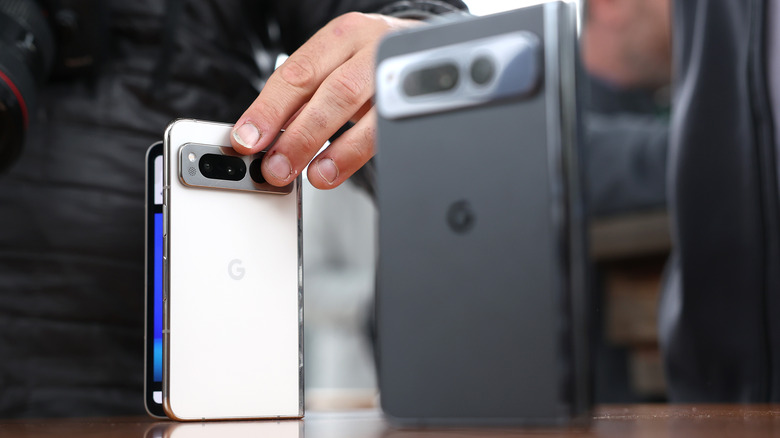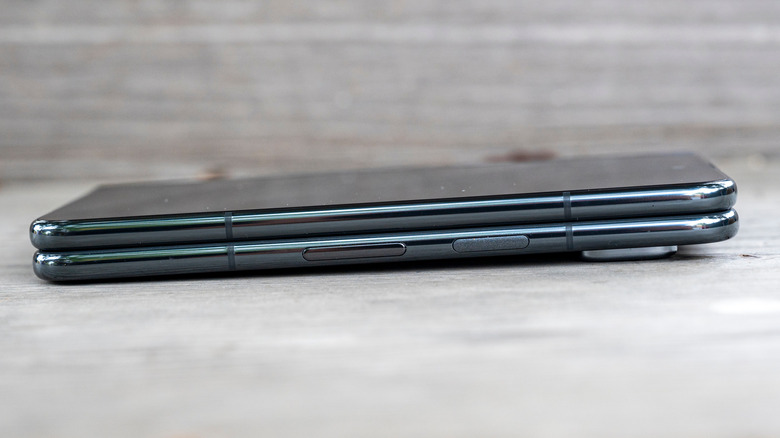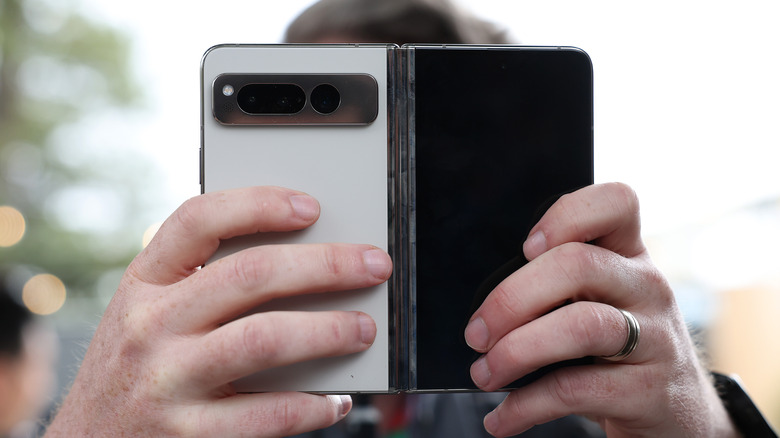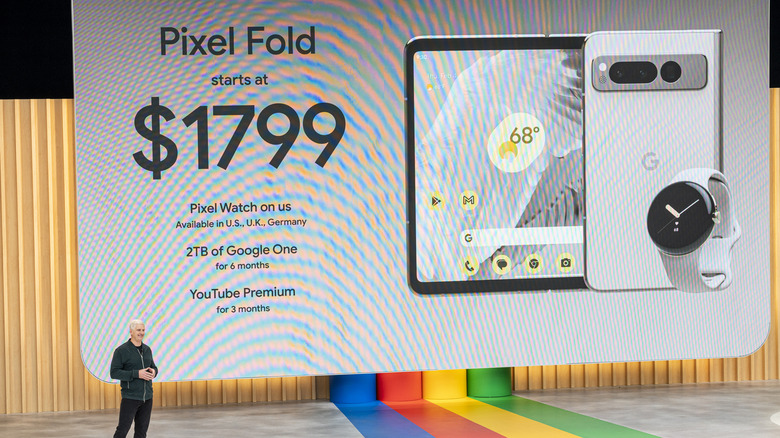Things Google Pixel Fold Needs To Do Right To Beat Samsung's Galaxy Z Fold
As we await full reviews of Google's first-ever foldable, the Google Pixel Fold, it's clear this device marks a turning point for its product category. Previously, Samsung dominated the market with its Galaxy Z lineup, led by the highly-rated flagship Galaxy Z Fold 4. If you wanted another tablet-style folding phone, you'd be hard-pressed to find one without importing it from abroad, most likely losing out on Google services in the process.
The Pixel Fold represents a planted flag signaling Google's commitment to developing versions of Android that third-party OEMs won't need to build clumsy workarounds for in order to run them on dual-screen devices. But if the maker of Android wants to unfold into a new market segment, it will have that aforementioned Samsung dominance to contend with. The Korean manufacturer has had years to polish its Galaxy Z Fold after the rocky launch of the first-generation model in 2019, and is now on version four, with the Z Fold 5 likely to launch late this summer.
Meanwhile, Google has had a few years to observe what Samsung and others have been doing with foldables, meaning the Pixel Fold appears to be a much more refined device than other first-gen foldables. At a launch price of $1,799, the Pixel Fold is clearly going toe-to-toe with Samsung's Galaxy Z Fold 4, so here are the most crucial elements of a folding phone Google needs to get right in order to take on Samsung.
A durable inner display
It's no secret that durability is the biggest downside to foldables right now. That's because, in order to make a display bend in half, the material it's made from needs to be incredibly thin. Both Samsung and Google use ultra-thin glass in their foldables, which is about as delicate as it sounds. Meanwhile, moving parts in a phone make it harder to achieve waterproofing and dust resistance while adding more potential points of failure. Many owners of Samsung foldables have reported screen cracking, and those devices come with preinstalled screen protectors in an effort to boost their durability.
But if Google can put out a foldable with a more durable display, that could be enough to convince more hesitant shoppers to take the foldable plunge. Ideally, you aren't giving up quality of life in order to own a foldable phone, and having the peace of mind to throw your phone into a bag without worrying about the scratches with which it might emerge would be a major selling point and leg up on the competition for the Pixel Fold.
A fully featured outer display
Over several generations of its Z Fold line, Samsung figured out that people want the outer display of a tablet-style foldable to be just as usable as any candy bar phone. The Galaxy Z Fold 4 has a massive 120Hz, 6.2" AMOLED display, allowing it to be a normal-looking phone when you need to quickly reply to a text or anything else that doesn't need the massive inner display. To be competitive, Google's Pixel Fold needs the same caliber of display on the outside that it already puts into the Pixel 7 Pro.
Luckily, the Pixel Fold looks competitive on this front. It comes with a slightly smaller 5.8" display but features an OLED panel running at a buttery smooth 120Hz and is made of Corning Gorilla Glass Victus, meaning it should survive most ordinary drops. While it doesn't massively outclass Samsung's approach, it is at least in the same ballpark. Fun fact, though: as noted by SamMobile, the displays on the Pixel Fold are manufactured by Samsung, which also supplies screens to Apple's iPhone lineups.
Additionally, Google has gone with a pleasingly different aspect ratio compared to Samsung's. The Pixel Fold's cover screen is shorter and wider than the Galaxy Z Fold 4's tall and thin display, which makes it feel more like the Moleskine notebooks Google says it drew inspiration from, per Fast Company.
An edge-to-edge main display
One thing that's obvious from SlashGear's hands-on with the Pixel Fold is that it's got some pretty chunky bezels around the inner display that look way thicker than those found on the Z Fold. For consumers who have gotten used to almost invisible bezels on their phone, that's going to make the Pixel Fold feel instantly dated.
The bezels are big for good reasons, though. Portions of the hinge mechanism have been incorporated into the top and bottom bezels, allowing the phone to close completely flat and open into a remarkably thin profile. Think of it like the doors on a Mercedes or other high-end automobile, which are known to close with a much more satisfying sound and feel because they have been carefully engineered. Google kept the same tangibility in mind, saying in a blog post that it wanted the Pixel Fold to feel like a piece of jewelry or another luxury item. Compared to the Samsung Galaxy Z Fold, which closes into a slight teardrop shape that leaves a gap and can expose the inner screen to dust or debris, Google's approach seems more considered.
Of course, bigger bezels may make the device more comfortable to hold, but they certainly make the Pixel Fold look a bit dated, even if they might feel more premium.
A battery champion
One major spec Samsung forwent on the Galaxy Z Fold 4 is battery capacity. While the more conventional Galaxy S23 Ultra comes packed with a beefy 5,000 mAh cell, the more expensive Z Fold 4 only manages 4,400 mAh, meaning it has less juice to power a much bigger screen.
The Pixel Fold takes the lead here by offering a battery with a 4,821 mAh. Of course, battery life is about more than mere cell size. Phones with massive batteries can underperform in battery life if their software is unoptimized or if the device has a power-hungry chipset. Whether the larger battery on the Pixel Fold translates into better battery life than the Z Fold 4 will depend on how well the Tensor G2 chip inside of it is optimized and how efficiently its version of Android manages power consumption.
Google has had the advantage of being able to combine an in-house SOC with an in-house design and in-house software, the same combination of factors that have consistently helped iPhones to outclass Android devices in performance for so long. But many iPhones have fallen short in terms of battery life. This is one area that will require a lot of real world Pixel Fold testing to determine conclusively.
A top-tier hinge
The hinge of a foldable phone is extremely important, and it's one area where Samsung is lagging behind other foldable manufacturers. The Z Fold 4 still folds into a teardrop shape instead of closing totally flat. But Chinese manufacturers are already putting out foldables that are able to close seamlessly like a laptop, and Google needs to embrace a similar design.
Thankfully, the hinge appears to be one of the Pixel Fold's highlights. As outlined earlier, Google has taken some bold swings here (pun intended), and they appear to have paid off. As reported by Fast Company, Google spent time studying how different things closed shut—books, car doors, and cigarette cases, to name a few—and the result is one of the nicest hinges seen on a folding phone.
Of course, a lot of real-world testing is necessary to see how those hinges hold up in the long run. For now, though, it looks like Google has managed to beat Samsung when it comes to one of the core components of a foldable.
Robust multitasking capabilities
The big selling point for tablet-style foldables is multitasking. Samsung's One UI skin for the Galaxy Z Fold 4 puts a taskbar at the bottom, along with many other multitasking features like windowed apps, side-by-side app layouts, and a laptop-esque Flex Mode, making it a productivity powerhouse. Many of those features even extend down to the Galaxy S23 Ultra.
Google's Pixel-exclusive version of Android has always been relatively simple compared to One UI, and while that may be just fine on a candy bar-style phone like the Pixel 7 Pro, that kind of bare-bones user experience won't cut it on a foldable. The Pixel Fold needs to be capable of taking advantage of its massive inner display.
There are certainly some great multitasking features on the Pixel Fold. The company demoed a floating taskbar that emerges from the gesture bar at the bottom of Android's UI. It also has something similar to Flex Mode that it calls Tabletop Mode. But at launch, only two apps can run side-by-side, and there's nothing close to the desktop-like windowed apps available on Samsung flagships.
A top-notch processor
One area where Google could potentially eat Samsung's foldable lunch is in the processor department. Because the Galaxy Z Fold line tends to release in late summer, it usually ends up getting a flagship Qualcomm chip only a few months before Qualcomm refreshes the lineup. For example, the Galaxy Z Fold 4 was one of the last major phones to ship with a Qualcomm Snapdragon 8+ Gen 1 when it launched in August 2022, a slightly more efficient version of the earlier Snapdragon 8 Gen 1. But by the time the Galaxy S23 lineup debuted in February 2023, they were rocking the Snapdragon 8 Gen 2, making the Fold 4 look a bit dated.
Google is shipping the Pixel Fold with Google's own Tensor G2 processor. That's the same chip found in the Pixel 7 Pro, and it's certainly no slouch, but with the Pixel Fold needing to push a lot more, well, pixels, we'll have to see how it holds up in real-world testing to know whether it can go toe-to-toe with the Galaxy Z Fold 4, or even the Z Fold 5 set to launch later in the year.
Water and dust resistance
Remember when putting your phone too close to the bathroom sink could easily spell the end of its lifespan? Those days are mostly behind us now, as most mainstream smartphones from companies like Apple, Samsung, and, yes, Google now ship with IPXX water and dust resistance. You still shouldn't take your phone into the shower, since no waterproofing is foolproof, but you theoretically can.
For a few years, foldable phones took us back to the days of stashing away your phone when it gets rainy. With all those moving parts and delicate displays, foldables were extremely vulnerable to water and dust damage. But since durability was the major weak point, companies like Samsung put a lot of effort into improving it. The Galaxy Z Fold 4 still doesn't include dust resistance, but it is rated IPX8 water resistant up to 1.5m for 30 minutes.
The Google Pixel Fold lives up to the competition, boasting an IPX8 certification. In fact, waterproofing is another area where Google is thinking outside the box. The Pixel Fold's unique build splits the design into two halves, sort of like Microsoft's dual-screen Surface Duo but with the interior screen floating across the gap between. Underneath the screen, water can actually free-flood through the middle of the phone without penetrating into the internals.
Cameras worthy of the Pixel name
For years, the Google Pixel was the undisputed camera champion in the smartphone landscape. Google's advances in computational photography and post-processing allowed the company to reuse the same 12-megapixel lens all the way through the Pixel 5. But the Pixel's dominance has slipped as other companies from Samsung to Apple stepped up their own computational game. While the Pixel 7 and 7 Pro still take very nice photos, Google can no longer rest on its laurels in the photography department.
Cameras, though, are one area in which the Pixel Fold could easily outclass Samsung. The Korean manufacturer reserves its best mobile cameras for its Galaxy S Ultra phones while the Galaxy Z Fold line is consistently left with more midrange lenses. The Z Fold 4 has a 50MP main lens. No slouch, but nothing close to the 200MP sensor found on the Galaxy S23 Ultra. It's a shame, since the foldable form factor allows for a variety of creative shots that can't be replicated by a candy bar design.
Google went with a 48MP main shooter for the Pixel Fold, only 2MP fewer than found on the Pixel 7 Pro. There's also a 10.8MP telephoto and 10.8MP ultrawide. But again, this is where Google's software has traditionally made the difference. The Pixel Fold should also have a better selfie camera experience since Google put the camera into the interior bezels rather than the notoriously fuzzy under-display camera found on the Z Fold 4.
The Pixel Fold needs to undercut Samsung's Galaxy Z Fold on price
Perhaps the most important feature, more important than displays, cameras, or batteries, is the price of the Pixel Fold. While Pixel phones have rarely been the best devices in terms of raw specs, they have often been best-in-class when it comes to value. With the eye-watering price tags Samsung attaches to its foldables, Google has a massive opportunity here.
Samsung's Galaxy Z Fold 4 is the most expensive phone in its lineup, starting at $1,799 for the base 256GB model, $1,919 for 512GB, and capping out at a whopping $2,159 for the 1TB variant. You could easily get a rather beefy gaming PC for the same price. Unfortunately, Google has chosen to match Samsung on pricing, starting at $1,799 for the base model with 256GB of storage at launch. It tops out at $1,919 for the 512GB model, with no 1TB option available. If you pre-order, Google will throw in a free Pixel Watch, which retails for $349.
If Google can undercut Samsung by even a few hundred dollars, the Pixel Fold will start to look like a tempting proposition. Both phones are likely to get steep discounts in the months to come, especially toward the end of the year and the holiday season. But at MSRP, price won't be a decisive factor for anyone choosing between the Pixel Fold and Galaxy Z Fold 4. Instead, it will come down to which features they care about.
